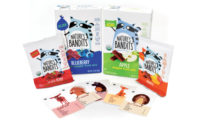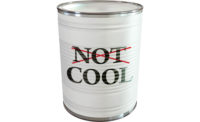Insights & Advice from Industry Leaders Featuring Little Big Brands

John Nunziato of LITTLE BIG BRANDS (LBB)

Richard Palmer, creative director at LBB.

Old Skool can be cool, but for this produce company, it was time to take their consumer communications to the next level. LBB was thrilled to partner with Ready Pac in all aspects of branding and communication including: strategic planning and innovation, packaging, internal communications and consumer advertising.

Fresh Prep’d Wrap Kits

Fresh Prep’d Soup Kits





As founder and chief creative officer of LITTLE BIG BRANDS (LBB), John Nunziato brings his strategic knowledge of global brand development to every project and works directly with clients on a daily basis, but as a small business owner, he’s the IT guy, beer tap fixer and office DJ.
BRANDPackaging: what makes LBB different from other branding firms?
John: One of the things we are most proud of at LITTLE BIG BRANDS is the quality of our creative product. Our agency is hyper-creative while having a strong anchor in brand strategy and realistic client goals and expectations. We operate with very little ego and a willingness and desire to work hand-in-hand with our clients to create impactful work.
Bp: what is packaging’s role in brand awareness?
John: Today packaging is everything given that very few dollars are being funneled into traditional marketing channels. Social media presents package design in many different forms, albeit sometimes over embellished in comparison to its shelf personality. And at the end of the day, a brand’s packaging is often a consumer’s first experience with a brand, so it needs to work hard without additional support.
Bp: what are some of the biggest challenges brands are facing today?
John: A big challenge for brands is finding a true point of difference. Anyone can make a me-too brand or capitalize on other brands’ success, but finding something that really makes it worth being chosen over the competition is the special sauce. So many brands fail or flounder because they aren’t willing to do the work to understand their point of difference. Because of that, most brands don’t live up to their potential and are at risk of losing relevance. Consumers, now more than ever, demand a lot from the brands they support, plus the retail environment is
the most challenging it has ever been. Brands that are willing to embrace those challenges in ways that make sense will ultimately weather the storm.
Bp: how does LBB help brands develop an overall strategy?
John: First, we ask our clients for sufficient time to do our homework. I think too many agencies present a one-size-fits-all strategic process—which is bunk—and jump right in. Next, we ask a ton of questions. It’s not that we haven’t been paying attention, it’s that we need to understand our client’s brand as well, if not better, than they do. We don’t consider the team “agency and client,” but rather as one integrated design team where all questions should be openly considered, because let’s face it: it’s in the nuance where you find the magic. This is the foundation for our strategic work, and it’s a fresh approach to what you’ll find at most agencies.
Bp: what was the first brand that made an impact on you?
John: I fell in love with idea of brands and branding due to an upbringing void of it. When I was young we didn’t have very much financially, and Pathmark’s NO FRILLS brand was a staple in my home. It looked like a military product, designed by an engineer. The communication was unbelievably simple and the design non-existent. I suppose you could say I had a love/hate relationship with the brand. I was quite embarrassed of it as a kid but it started me down the path I’m on today. So, thank you NO FRILLS!
Brand Packaging also spoke with Richard Palmer, creative director at LITTLE BIG BRANDS, who shared his favorite childhood brand and shared the behind-the-scenes branding strategies of a product launch.
BP: Do you remember the first brand whose packaging you fell in love with?
Richard: Absolutely! It was Matey Bubble Bath. I probably first experienced the product at the age of five. Their advertising tagline was, “Clean Fun, Clean Kids, Clean Bath” so my parents benefited from the product too. Honestly, I think it was the simplicity of the male and female characters, and the structure that resonated with me as a kid.
https://www.youtube.com/watch?v=YqL-2wmF7dw
BP: What is packaging’s role in brand awareness?
Richard: It varies tremendously depending on the size of the brand, its regional, national or global reach and its marketing budget. At LBB we are fortunate to work with a vast array of clients from small start-up brands where the packaging is necessary to create awareness to large corporate brands with enormous marketing and advertising budgets, where packaging is a part of an array of assets which grow brand awareness.
BP: Tell us how LBB helps brands develop an overall strategy
Richard: In the case of our Ready Pac Foods client, it started with business strategy: Helping them understand how they could innovate in a way that made sense for them and the marketplace. And how to capitalize on trends and untapped needs, while aligning those with business goals and capabilities. The answer was utilizing their success in fresh salad kits to fulfill other meal occasions and provide consumers with solutions they didn’t currently have. Out of that, the Fresh Prep’d brand was born with the first two fresh offerings being wrap and soup kits. Along the way we always inform our work with consumer insights and feedback—whether it be validating the initial concept, understanding the consumer’s wants and needs, or optimizing the pack design. And we take into consideration how our brand can live and be brought to life across a wide range of touchpoints, not just packaging.
Looking for a reprint of this article?
From high-res PDFs to custom plaques, order your copy today!











